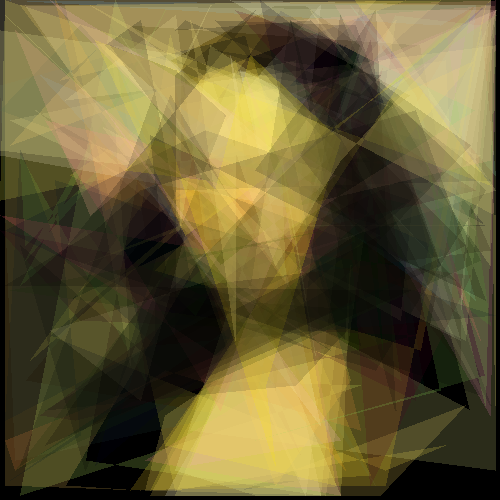Image approximation with geometrical shapes¶
This notebook shows how grammar-guided genetic programming (G3P) can be used for a task invented by Roger Johansson: search for a configuration of semi-transparent geoemetrical shapes, so that the resulting image closely resembles a given target image.
Note that it requires the library pillow to draw images. It can be installed with pip install pillow.
References¶
[1]:
import time
import alogos as al
import IPython
from PIL import Image, ImageDraw, ImageChops, ImageStat
Preparation¶
1) Functions for handling images¶
[2]:
def load_image_from_file(filepath):
return Image.open(filepath).convert('RGB')
def store_image_to_file(img, filepath):
img.save(filepath)
def store_string_to_file(img, filepath):
with open(filepath, 'w') as f:
f.write(string)
def resize_image(img, width):
w, h = img.size
height = int(width * h / w)
return img.resize((width, height), Image.Resampling.LANCZOS)
def display_image(img):
IPython.display.display(img)
2) Functions for drawing shapes¶
[3]:
def create_image(width, height, bg_color='black'):
return Image.new('RGB', (width, height), bg_color)
def create_drawer(img):
return ImageDraw.Draw(img, 'RGBA')
def circle(d, x, y, r, c):
d.ellipse(((x-r, y-r), (x+r, y+r)), c)
def ellipse(d, p, c):
d.ellipse(p, c)
def triangle(d, p, c):
d.polygon(p, c)
def quadrilateral(d, p, c):
d.polygon(p, c)
def pentagon(d, p, c):
d.polygon(p, c)
def hexagon(d, p, c):
d.polygon(p, c)
def heptagon(d, p, c):
d.polygon(p, c)
def octagon(d, p, c):
d.polygon(p, c)
def nonagon(d, p, c):
d.polygon(p, c)
def polygon(d, p, c):
d.polygon(p, c)
3) Target image¶
[4]:
img_name = 'mona_lisa'
img_ori = load_image_from_file(img_name + '.png')
# smaller image size leads to much faster objective function evaluation
size = 70
img_target = resize_image(img_ori, size)
[5]:
display_image(img_target)

Definition of search space and goal¶
1) Grammar¶
This grammar defines the search space: a Python program that creates an empty image and draws a chosen number and type of geometrical shapes on it, with locations and colors being variable.
[6]:
ebnf_template = """
PROGRAM = IMAGE NL DRAWER NL SHAPES
IMAGE = "im = create_image(w, h)"
DRAWER = "d = create_drawer(im)"
SHAPES = {chosen_number}
SHAPE = {chosen_shapes}
CIRC = "circle(d, " X "," Y "," R "," C ")"
ELLI = "ellipse(d,(" PT "," PT ")," C ")"
TRI = "triangle(d,(" PT "," PT "," PT ")," C ")"
QUAD = "quadrilateral(d,(" PT "," PT "," PT "," PT ")," C ")"
PENT = "pentagon(d,(" PT "," PT "," PT "," PT "," PT ")," C ")"
HEX = "hexagon(d,(" PT "," PT "," PT "," PT "," PT "," PT ")," C ")"
HEPT = "heptagon(d,(" PT "," PT "," PT "," PT "," PT "," PT "," PT ")," C ")"
OCT = "octagon(d,(" PT "," PT "," PT "," PT "," PT "," PT "," PT "," PT ")," C ")"
NONA = "nonagon(d,(" PT "," PT "," PT "," PT "," PT "," PT "," PT "," PT "," PT ")," C ")"
POLY = "polygon(d,(" POINTS ")," C ")"
POINTS = PT "," PT | POINTS "," PT
PT = X "," Y
X = FRAC "*w"
Y = FRAC "*h"
R = FRAC "*w/2"
C = "(" INT "," INT "," INT ", {chosen_alpha})"
FRAC = "0." DIG DIG
INT = "int(" FRAC "*255)"
DIG = "0" | "1" | "2" | "3" | "4" | "5" | "6" | "7" | "8" | "9"
NL = "\n"
"""
def generate_grammar(num_shapes=150, shapes='CIRC | ELLI | TRI | QUAD | PENT | POLY', alpha=50):
"""Parameterized generation of the grammar: Choose number and type of drawn shapes."""
ebnf_text = ebnf_template.format(
chosen_number='SHAPE NL '*num_shapes, chosen_shapes=shapes, chosen_alpha=alpha)
grammar = al.Grammar(ebnf_text=ebnf_text)
return grammar
grammar = generate_grammar(50, 'NONA')
2) Objective function¶
The objective function gets a candidate solution (=a string of the grammar’s language) and returns a fitness value for it. This is done by 1) executing the string as a Python program, so that it draws a candidate image, and then 2) pixel-wise comparing the candidate image with the target image: the smaller the difference, the better is the candidate.
[7]:
w, h = img_target.size
var = dict(
w=w,
h=h,
create_image=create_image,
create_drawer=create_drawer,
circle=circle,
ellipse=ellipse,
triangle=triangle,
quadrilateral=quadrilateral,
pentagon=pentagon,
hexagon=hexagon,
heptagon=heptagon,
octagon=octagon,
nonagon=nonagon,
polygon=polygon,
)
var_large = var.copy()
var_large['w'] = 500
var_large['h'] = 500
[8]:
def run_python_code(string, var=var):
exec(string, var)
return var['im']
[9]:
def px_diff(im1, im2):
return sum(ImageStat.Stat(ImageChops.difference(im1, im2)).sum)
[10]:
def objective_function(string):
img = run_python_code(string)
return px_diff(img, img_target)
Generation of a random solution¶
Check if grammar and objective function work as intended.
[11]:
random_string = grammar.generate_string()
print('A random string:')
print(random_string[:500], '.........')
print()
print('Visualized:')
img = run_python_code(random_string)
display_image(img)
print()
print('Fitness value assigned by the objective function:', objective_function(random_string))
A random string:
im = create_image(w, h)
d = create_drawer(im)
nonagon(d,(0.18*w,0.80*h,0.70*w,0.72*h,0.54*w,0.00*h,0.45*w,0.92*h,0.17*w,0.38*h,0.35*w,0.09*h,0.15*w,0.97*h,0.15*w,0.09*h,0.31*w,0.32*h),(int(0.52*255),int(0.00*255),int(0.77*255), 50))
nonagon(d,(0.48*w,0.53*h,0.67*w,0.40*h,0.97*w,0.46*h,0.70*w,0.69*h,0.37*w,0.52*h,0.68*w,0.49*h,0.20*w,0.95*h,0.00*w,0.26*h,0.09*w,0.67*h),(int(0.09*255),int(0.54*255),int(0.36*255), 50))
nonagon(d,(0.64*w,0.45*h,0.50*w,0.71*h,0.60*w,0.16*h,0.95*w,0.84*h,0.00*w,0.43*h .........
Visualized:

Fitness value assigned by the objective function: 1166740.0
Search for an optimal solution¶
Evolutionary optimization with random variation and non-random selection is used to find increasingly better candidate solutions.
1) Parameterization¶
[12]:
report_time = True
display_results = True
store_results = False
num_ind = 2
num_gen = 25_000
[13]:
ea = al.EvolutionaryAlgorithm(
grammar, objective_function, 'min', population_size=num_ind, offspring_size=num_ind)
2) Run¶
The search is performed one generation after another and some intermediate results are reported to see how the solutions improve gradually.
[14]:
start = time.time()
for i in range(1, num_gen+1):
best_ind = ea.step()
if i % 1000 == 0:
string = best_ind.phenotype
if report_time:
dt = time.time() - start
print('{}: {:.0f}min {:.0f}s'.format(i, dt // 60, dt % 60))
if display_results:
img = run_python_code(string)
display_image(img)
if store_results:
img = run_python_code(string, var_large)
store_image_to_file(img, 'results/{}_n{}_s{}_g{}.png'.format(img_name, args[0], args[1], i))
store_string_to_file(string, 'results/{}_n{}_s{}_g{}.txt'.format(img_name, args[0], args[1], i))
1000: 0min 13s

2000: 0min 24s

3000: 0min 35s

4000: 0min 46s

5000: 0min 57s

6000: 1min 8s

7000: 1min 19s

8000: 1min 30s

9000: 1min 41s

10000: 1min 53s

11000: 2min 4s

12000: 2min 15s

13000: 2min 26s

14000: 2min 38s

15000: 2min 49s

16000: 2min 60s

17000: 3min 11s

18000: 3min 22s

19000: 3min 33s

20000: 3min 45s

21000: 3min 56s

22000: 4min 7s

23000: 4min 19s

24000: 4min 30s

25000: 4min 42s

3) Result¶
Show the phenotype of the best individual found so far. If more computing time is provided, increasingly better solutions can be found.
[15]:
print('Preliminary result after {} generations'.format(ea.state.generation))
string = best_ind.phenotype
img = run_python_code(string, var_large)
display_image(img)
Preliminary result after 25000 generations
